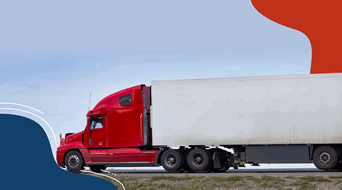4 Smart Ways To Get the Best Truckload Shipping Rates (and 3 Things To Avoid!)
When it comes to truckload shipping, the cost can sometimes be a bit of a shock, especially if you're shipping large or heavy goods. Moving freight is always going to cost more than shipping smaller packages, but the final full truckload (FTL) shipping rates depend on many factors.
While some of these are unavoidable — like the weight of the goods or the distance the shipment needs to travel — there are several things you can control that could help lower your truckload freight shipping costs. The trick is knowing what to focus on.
In this guide, we'll show you four smart ways to get the best full truckload shipping rates, plus three things to avoid that could end up increasing rates. Let's get started!
Ways To Get the Best Truckload Shipping Rates
1. Trade time for FTL savings
One of the simplest ways to reduce truckload freight shipping costs is by adjusting your delivery timeframes. Different delivery speeds come with different price tags. If you're flexible on delivery time, you could save a significant amount of money by choosing a slower service.
Consider whether your FTL freight can arrive a day or two later and still meet customer needs. You may also be able to plan ahead and ship earlier to secure the same delivery date at a lower cost.
These small shifts can make a big difference in your overall FTL shipping costs. By being a bit more flexible with your delivery schedule, you can find a more economical solution that still meets your business needs.
2. Be prepared and accurate
Always remember, the upfront truckload freight quote is just the beginning. That's because unexpected fees can quickly derail your budget if you're not careful. FTL freight shipments can come with accessorial charges that can really add up. Some of the most common ones include:
- Redelivery fees: These are charged if the shipment cannot be delivered on the first attempt.
- Liftgate charges: If the consignee doesn't have a loading dock, you'll incur liftgate fees to unload your shipment.
- Missed delivery windows: If your shipment isn't ready when the driver arrives, you could face delays and extra charges.
- Different freight service types: Different services like dry van, flatbed and refrigerated freight have varying costs and potential accessorial charges. Understanding these can help you avoid unexpected fees and charges.
To avoid these accessorial charges, it's essential to be as accurate and prepared as possible. Ensure your shipment is ready on time and communicate clearly with your carrier to avoid these fees. Taking the time to understand common accessorial fees will help you avoid costly surprises that can affect your bottom line.
3. Know when LTL or PTL is a better deal
Truckload shipping is ideal for large shipments, typically over 15,000 lbs. or more than 10 pallets. However, if your shipment is smaller, it may not make sense to go with full truckload shipping. In these cases, consider less-than-truckload (LTL) or partial truckload (PTL) options.
- LTL freight: If your shipment is less than 15,000 lbs., LTL might be a good fit. You share truck space with other shipments, which can reduce your overall cost.
- PTL freight: This option is for shipments that are larger than LTL but don't fill an entire truck. Your freight shares space with other shipments, making it more affordable than FTL freight while still offering direct service.
If you're on the fence about whether FTL freight is necessary, consider these alternatives. Shipping costs can be drastically reduced by choosing the right option for your freight's size and weight.
4. Partner with a freight shipping 3PL
Another way to get the best truckload shipping rates is by working with a third-party logistics (3PL) provider. Here's how partnering with a 3PL can benefit you:
- Better rates: 3PLs have established carrier partnerships and can leverage their relationships to get discounts on full truckload shipping.
- Optimized load planning: 3PLs are experts at ensuring that trucks are fully utilized, which reduces wasted space and maximizes efficiency, cutting costs.
- Cost-effective routes: Their deep knowledge of carrier networks and routes helps them find the most efficient, cost-effective paths for your shipments.
By utilizing 3PL expertise, you can save money and time while ensuring your shipments are delivered on time and within budget.
What NOT To Do When Shipping FTL Freight
While it's great to know what you should do to save on truckload freight shipping costs, it's just as important to understand what NOT to do. The options below may seem tempting at first, but they could cost you more in the long run.
1. Skimp on freight packaging
It's tempting to cut costs on packaging, but that could be a huge mistake. Inadequate packaging can lead to damaged goods, which will ultimately cost you more than the money you save on cheap materials. Damaged goods mean returns, refunds and unhappy customers — not to mention additional shipping fees.
When it comes to packaging, always aim for quality. Proper freight packaging will protect your shipment during transit, ensuring your goods arrive in excellent condition. Consider investing in sturdy, high-quality materials and use appropriate shipment preparation techniques to prevent unnecessary issues and costs.
2. Assume the cheapest FTL offer is best
While it's natural to gravitate toward the cheapest quote, this isn't always the best approach when choosing a carrier. Some freight carriers that offer low rates may not disclose standard surcharges or hidden fees in their quotes, which could ultimately increase your shipping costs.
Additionally, focusing on price alone without considering the carrier's reputation can be detrimental. Poor service, delayed shipments and frequent damages can lead to significant financial losses and a hit to your business reputation. Always take into account the carrier's reliability and the transparency of their pricing before making a decision.
If you're unsure about a carrier, a 3PL can help you select a vetted, trustworthy carrier partner that provides transparent and competitive rates, ensuring that you get the best deal without sacrificing quality.
3. Not considering freight insurance
Another mistake many shippers make is opting out of freight insurance or additional protection for their shipments to save on upfront costs. While it may seem like a smart move at the time, this could backfire if something goes wrong.
FTL freight shipments are generally insured by the carrier, but the liability is limited. If your goods are damaged or lost during transit, you could be left with significant financial losses. Opting for comprehensive freight coverage might seem like an extra expense, but it's an important cost-saving measure in the long run. Affordable insurance coverage can provide peace of mind and ensure that you're protected if anything goes wrong.
Talk To the Experts to Get the Best Rates
The best way to ensure you're getting the most competitive truckload shipping rates is to talk to a shipping expert. A 3PL provider can help you optimize your shipping strategy, negotiate better rates and ensure that you choose the right option for your shipment's size, weight and destination.
If you're looking to reduce your full truckload shipping rates or need help navigating the complexities of truckload freight shipping, reach out to an expert today. They can help you save time, money and frustration while delivering your goods efficiently and reliably.
Contact a shipping expert now and start getting the best rates for your truckload freight shipping needs. Reach out to Unishippers for a free, customized shipping consultation.


